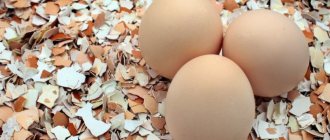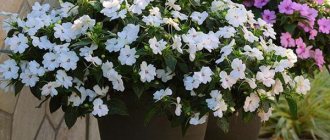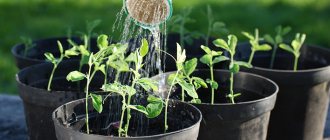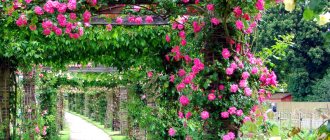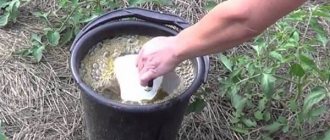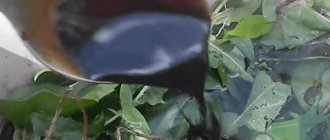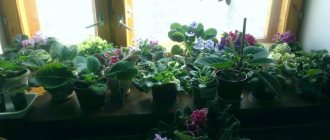Category: For flowers and indoor plants Reading time: 8 min · Views: 5,981
Everyone knows the property of ammonia to bring one to consciousness in case of loss of consciousness - not least because of the unbearably pungent odor. But less is known about the use of this liquid as a fertilizer. Read this article about how and why ammonia is used for plants.
Action mechanics
There is no mechanism for the accumulation of ammonia molecules in plants, or, more correctly, there is no “ammonia depot”. This means that it is impossible to overfeed any crops with ammonia - the plant simply will not absorb it, and an excess of such applied fertilizer will cause burns to the roots.
The fact is that the nitrogen contained in an aqueous solution of ammonia is absorbed by plants only after oxidation by air oxygen into ammonium form; destructor microorganisms do not participate in this process. What does this mean in practice? No nitrates are formed, if that's important to you. Well, it may be important in cases where after flowering no edible fruits or tubers are formed.
Content
- Negative impact on soil
- For plants
- What is it and why
Avius Quovis / Flickr.com
Ammonia ( ammonia alcohol - 10% ammonia-ammonium, ammonia water - 25% ammonia-ammonium) has a suffocating odor, evaporates , introducing it into the soil requires quick incorporation, in high concentrations it is toxic to a wide range of microorganisms and soil invertebrates - to everyone contract.
Discuss the video
Nitrogen fertilization
NH3H2O or, in the more familiar form of ammonium, NH4OH. That is, this substance is literally stuffed with nitrogen. Nitrogen in crop production is the green mass, the healthy and strong appearance of leaves and stems, and a developed root system.
But there are nuances in using ammonia as a top dressing that must be taken into account.
- Ammonia diluted in water in the dosages indicated below is largely used as a means of awakening flowering potted plants after hibernation. Plants that do not bloom can be content with this feeding no more than 2 times a month.
- The product is strong, so the 10% solution sold in pharmacies is not suitable in any case! Its use in its pure form will simply kill any plant. Therefore, the “impact” dose that forces plants to awaken after winter is 1.5-2 tablespoons of 10% ammonia per 5 liters of water.
- Plants should be fed with this product no more than once every 2 weeks, starting from about mid-February, when the length of daylight compared to the end of December becomes noticeable. Fertilizing is done regardless of the frequency of watering with ordinary water or the need of certain plants for nitrogen: this need must be satisfied in the composition of complex nitrogen-containing fertilizers.
- Diluting this liquid in water is also not so easy: ammonia will remain in it for a long time in layers, not wanting to mix. For complete dissolution, you need to use warm water, 30-35 degrees. After dissolving the ammonia in it, wait until it cools to room temperature.
- Fertilizing is carried out on damp soil, that is, the solution should be poured into flower pots 20-30 minutes after regular watering.
- Fertilizing plants with a solution is done strictly at the root! To do this, you need to have a special watering can with a thin spout, without a sprinkler at the end, which will allow you to pour the solution exactly under the root of the plant, preventing its drops from falling on the leaves, which can cause chemical burns. Despite the precautions taken, it is still possible for drops to accidentally fall on the green parts of the plant. To neutralize their effects, it is useful to spray the plants with plain water in the form of an aerosol immediately after watering.
- After the massive appearance of buds and the beginning of flowering, the dosage can be reduced by half - a tablespoon and a quarter of ammonia per 5 liters of water.
- In winter, such fertilizing can be avoided at all or limited to once a month.
How does nitrogen deficiency manifest itself?
The following signs observed in flowers can serve as a signal to apply nitrogen-containing fertilizers:
- The leaves have acquired a yellowish tint, the green color has lost its saturation.
- The stems of the plants have become brittle, the bush is not held in a bunch, if it was previously inherent in it, but is spreading out, moving apart in different directions.
- New buds do not appear, and existing ones die and dry out.
- Flowering, if it occurs at all, lasts a short time.
Peculiarities
The big “plus” of ammonia is “superfluidity”. It gives water with it the ability to penetrate into the most remote parts of the soil in a flower pot and is guaranteed to nourish the roots. Under natural conditions, this opportunity provides plants with additional sources of nutrients, because the roots can easily reach areas and depths of the soil where mineral or organic fertilizers are still present.
Transplanting plants into new soil every spring does not solve the problem - the flower will suck out all the nutrients in 2-3 months, and additional feeding will be needed. Replant more often? And this means injuring the root system.
Using large pots will also not give any effect other than root growth.
This is especially true for all types of geraniums: it is not for nothing that flower growers say that geraniums in large pots “get impudent” - they almost stop blooming, but they produce a surprising amount of greenery.
Regular feeding of indoor plants with a solution of ammonia in water over time, after about a year, leads to an increase in soil acidity. Since liming it under conditions of pot cultivation is impractical, it is better to replace the soil, stopping any fertilizing about a month before.
Application rates
The maximum dose for feeding is liquid in the concentration of the active substance - ammonia, in water - 1 tbsp. spoon of 25% solution per liter. You can apply fertilizer in this dose only once.
- For watering flower crops grown in apartments (including bulbs), a fertilizing solution is made based on 50 ml of 10% ammonia and 10 liters of water. Don't need so much? Recalculate.
- If you need to treat seedlings or perform foliar feeding of already well-rooted flowers that have begun to grow, make a solution of 1 teaspoon per liter of water.
Ammonia solution cannot be used as the main nitrogen fertilizer due to its inability to form nitrate and nitrite compounds in the soil. It can be used for feeding only as a means of initiating awakening after hibernation or as an emergency aid for plants during nitrogen starvation.
Which plants can be fed with nitrogen?
- A medium concentration solution can be used to feed eggplants, zucchini, cabbage, pumpkin, rhubarb, and peppers.
- For fruit and berry bushes - plum, cherry, blackberry, raspberry, it is enough to pour a low concentration mixture under the root.
- A solution of medium and low dosage can be used to water cucumbers, tomatoes, garlic, corn, carrots, beets, apple trees, gooseberries, and currants.
- Radishes, onions, and pears will respond well to watering with a low dosage solution.
Before watering with ammonia, the plants should first be watered with plain water. Do not use this substance more than once a week, and start feeding with a small dosage.
Ammonia for plants as a means of protection
Since pests of indoor plants can enter the house through drafts (especially spider mites, which can travel tens of kilometers on their parachute webs), on clothes and shoes, in bags from stores along with purchased vegetables and herbs, the rule “my house is my fortress" does not work with them. They'll get there sooner or later anyway. Therefore, ammonia, which is almost always available in home first aid kits, will come to the rescue here too.
The most popular way to protect plants from pests is to add finely shaved laundry or baby soap to an aqueous solution of ammonia of a certain concentration.
Preparation of a protective solution
- Grate 100 grams of laundry or baby soap on a fine grater.
- Dissolve it in 1 liter of hot, 70-80 degrees, water.
- Pour the dissolved soap into 4 liters of cold, settled tap water in a thin stream, without vigorous stirring, so that soap foam does not form.
- A 50-gram pharmaceutical bottle of 10% ammonia is poured into the resulting liquid, slightly saturated with soap.
- Use the solution immediately as it is not stored.
The resulting mixture is sprayed over the entire plant from crown to base, paying special attention to the underside of the leaves. The fact is that mites, aphids or scale insects, against which such a soap solution is prepared, usually nest on the back side of the leaf, where the protective skin is matte and thinner. Which means it is accessible to destruction.
This soap-ammonia mixture will also be very effective against flying insects and ants.
Ants and wasps are generally very sensitive to ammonia. Those doses that will not have any effect on humans will be fatal to these creatures.
Soap is introduced into ammonia solutions mainly as a wetting agent and fixing the active substance on the leaves.
Preparation of solution and dosage
In order not to harm indoor plants, it is important to calculate the required amount of ammonium solution. Moreover, for different types of fertilizing its certain concentration is used. Thus, a low-concentrated composition is used to spray leaves, and a high concentration is used to fertilize the soil.
Ammonia is appropriate in the following cases:
- prevention and control of insect pests;
- disinfection of flower pots;
- Direct feeding of soil and greenery.
The fertilizer concentration option depends on the reason for its use.
Application against pests
Midges and thrips
Dilute 25 ml of 10% ammonia in 2 liters of settled tap water. Water the plant at the root, adding 100-150 ml of solution to the soil.
Aphids and weevils
Against aphids, you can use not only soap, but also a regular aqueous solution of ammonia. Only for this you need not only to treat the above-ground part of the plant, but also to do root watering. To do this, prepare a solution of 50 ml of 10% product per 7 liters of water; the resulting amount is simultaneously sprayed and watered at the root.
Soil pests
As a preventive measure against soil pests, when planting, you can pour 50-100 ml of solution (10% ammonia per 1 liter of settled tap water) into the hole prepared for this purpose.
This mixture will create a stable connection with the soil, which will protect the roots from pests for at least a year.
Benefits for indoor plants
Ammonia for indoor flowers (the use of this substance requires caution) is the optimal fertilizer. It is often used when growing hydrangeas, cyclamen, lilies, clematis, and geraniums. Flower growers note that when they start using an ammonia solution, the flowers become much larger and grow faster.
Thanks to the specific smell of ammonia, mole crickets, weevils and many other pests do not parasitize ornamental plants.
If, after the initial treatment, insects appear on the foliage after some time, then it is enough to use the ammonia solution again, and they are guaranteed to disappear. However, it is recommended to treat the above-ground part of the plant with ammonia only as needed.
Precautionary measures
Ammonia can enter the body not only, as doctors say, “orally,” but it can also be absorbed through the skin and mucous membranes. A person, unlike plants that do not have an “ammonia depot,” is subject to the cumulative action of ammonia, that is, it, having accumulated, can manifest itself suddenly. And poisoning with this substance is severe, with damage to the kidneys and urinary tract.
Therefore, the use of personal protective equipment in the form of latex gloves, masks and goggles is mandatory. If you notice a change in your health for the worse, immediately drink at least a glass of warm milk - only real milk, not milk-containing liquid from a package!
Aggressive ammonia vapors can also ruin many types of plastic coatings and even the insulation on wires.
Therefore, it is advisable to water and spray indoor plants with windows and doors open to create a draft without standing on the leeward side while doing this.
The effect of the drug in exterminating parasites
Ammonia is an aqueous solution of ammonium hydrate, consisting of volatile compounds of nitrogen and inorganic hydrogen (ammonia), and it has a pungent odor that repels insects.
In an individual exposed to ammonia vapor, the respiratory system is paralyzed and the insect dies. Having a sensitive sense of smell, parasites sense its presence for a long period of time and do not visit the treatment area.
Application in the garden
Ammonia solution is especially useful in the fight against pests such as all kinds of moths and butterflies that lay eggs, from which they will later hatch into all-devouring caterpillars. And also against soil inhabitants, cockchafers and their larvae, mole crickets and such a worst enemy of garden plants as wireworms.
And if a soap-ammonia solution works well against flying insects that lay eggs and larvae, then against underground inhabitants they use a simple remedy consisting of a solution of 50 ml of ammonia with a concentration of 10% in a bucket of ordinary water.
This solution is poured into holes intended for planting garden crops in an amount from 150 ml to one and a half to two liters, depending on what you plant: tomato, cucumber seedlings or tree seedlings.
Ammonia for flowers
Every summer resident must have flowers growing on his plot. Fertilizing with ammonia will also be useful for flowers. Flower growers recommend spraying when the flowers begin to fill buds. Pour 1 teaspoon of ammonia per liter.
In order for perennials to go into winter prepared, it is recommended to feed them at the root with the same solution.
The leaves are sprayed with a mixture consisting of one liter of water and a teaspoon of ammonia. Fertilizing is carried out after the leaves appear and during the formation of buds. Experienced gardeners prepare perennial garden flowers for winter by fertilizing them with ammonia.
Zinnias, peonies, dahlias, violets, nasturtiums, and clematis love a high concentration solution. And annual and bulbous flowers tolerate watering well in small dosages.
Properties of ammonia
Ammonia is a nitrogenous compound, and nitrogen is one of the main elements necessary for plant nutrition. Typically, in the garden, organic matter is used as a source of nitrogen - manure, litter, compost, humus. However, plants begin to absorb nitrogen from such fertilizers only after they are processed by bacteria.
Mineral fertilizers such as urea and saltpeter help quickly satisfy the plants' need for nitrogen. But when applying mineral fertilizers, there is always a risk that the seedlings will begin to accumulate nitrates. At the same time, ammonia, when applied to seedlings, does not accumulate in plant tissues, but provides the necessary nutrition.
You can notice that tomato or pepper seedlings are suffering from a lack of nitrogen by the following signs:
- The lower leaves become yellowish and pale.
- The leaf blades grow very small.
- The shoots become thin and fragile.
- The seedlings stop developing.
- The buds on the plants begin to deform.
Seedlings underfed with nitrogen will be very weak. Therefore, it is necessary to act immediately, otherwise there will be no harvest. If you start watering the sprouts with fertilizers based on ammonia, the seedlings begin to quickly gain green mass, bloom and are practically not attacked by parasitic insects.
There are many advantages to feeding seedlings with ammonia:
- Fertilizer quickly reaches the roots through the earthen ball.
- Plants grow very quickly.
- The bushes bloom profusely and bear fruit well.
- This fertilizer costs a penny.
- It is easy to apply.
- The drug has disinfectant properties.
- Completely environmentally friendly and harmless.
But the main advantage of fertilizing with ammonia is that plants do not accumulate nitrogen, which is very important when growing fruit and berry crops. Such fertilizers are completely harmless.
There are also disadvantages to this method. For example, you can accidentally overfeed your plants by preparing the nutrient solution incorrectly. The soil after treatment with ammonia becomes slightly acidic, so it is better to make a small channel for adding water to the plants at the very root.
The main thing when working with the drug is to correctly follow the recommended dosage, as well as the frequency of fertilizer application.
Cabbage, eggplants, potatoes, zucchini, peppers and tomatoes respond well to fertilizing with ammonia. Ammonia is also useful for flowering crops, such as zinnia, petunia, clematis and others. Plants can be fertilized throughout the entire growth period and during flowering.
There are plants that have low nitrogen intake. Radishes, any leafy vegetables and onions are rarely fed. But legumes don’t need ammonia at all.
Treatment of ant nests on the site
The carriers of aphids and their accomplices in reproduction are ants. It is necessary to carry out parallel treatment of anthills and nests of sucking insects. Otherwise, you may not expect any effect, because the “honey dew” secreted by aphids is the ant’s best delicacy. Not wanting to be deprived of food, they protect their benefactors, drag aphids onto fresh plants, and in the fall they hide them in their nests in order to bring them to freedom in the spring.
In addition, ants, partial to sweets, threaten the berry harvest, spoil nectar-producing plants, and infect them with diseases.
How to treat ant nests to ensure that the individuals on the site are destroyed? Boiling water and ammonia are an “explosive mixture” that can cause significant damage to the ant population. For this:
- boil water in a bucket;
- pour 25 ml of ammonia into boiling water;
- stir up the anthill in the center;
- pour the solution into the hole.
10 ways to get rid of wireworms in the garden
Cover the top with thick material or polyethylene to preserve the smell of ammonia longer. This should be done with all ant nests on the site.

